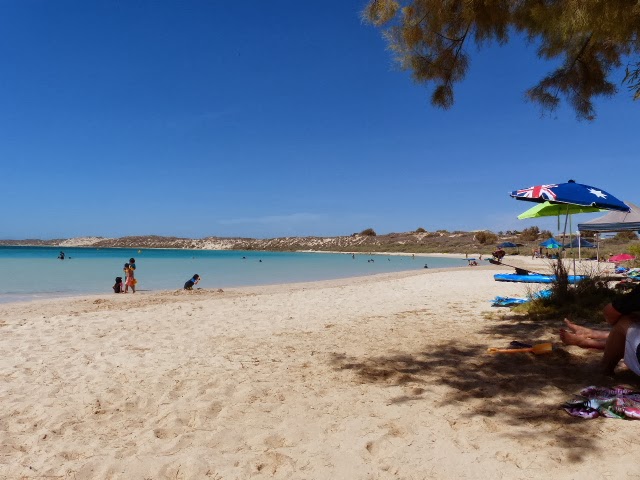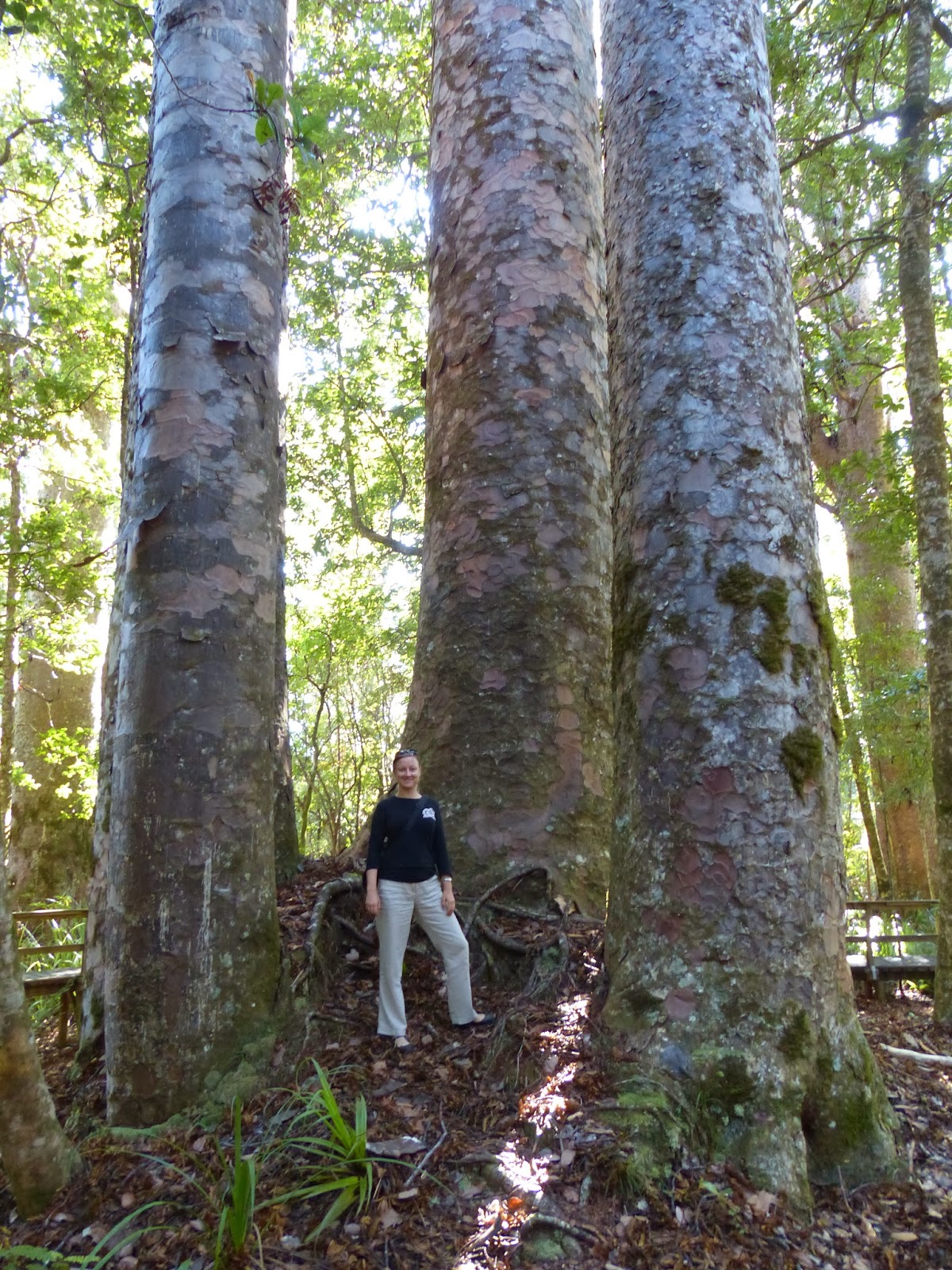The latest travels took us this time to Coral Bay, 1400 kms N of Perth (see map). Coral Bay is a small cute little village off the main highway north where one can best access Ningaloo reef. This is a fringe type reef, which means that it starts meters off the coast (as opposed to barrier reef like the Great Barrier Reef in Queensland that is kms away from the coast and you will have to take a boat to reach it). What do you do during a coastal exploration trip? That's right, you explore the coast and the waters and all its inhabitants.
Aastavahetuse paiku otsustasime s6ita p6hja uudistamaks kohta nimega Coral Bay, mis asub u. 1400 km Perthist p6hjas. Coral Bay on v2ike kylake, kust on k6ige parem ligip22s Ningaloo riffile, kus saab mugavalt ja lihtsalt kaeda seal elavaid kalakasi ja koralle.
(map source: http://www.perth-getaways.com/exmouth.html)
We were told that it is called Shark Bay world heritage area, because there are indeed lots of sharks there! I saw for the first time about 10 reef sharks, which were only about up to 1 m big and are apparently harmless to people.
First place on the way to Coral Bay where we made a longer stop was Monkey Mia which is well known for its dolphins' sighting. Little did i know that it isn't a town, but the whole place consists of one resort that has plenty of accommodation for different budgets and other amenities, but you need to pay a small fee to get in!
Esimene koht, kus me teel Coral Baysse pikema peatuse tegime oli Monkey Mia, mis on kuulus oma delfiinide poolest, kes kartmatult madalates vetes ujujaid uudistavad. Huvitav oli aga see, et tegemist polnud tavalise v2ikese linnakesega, nagu me ootasime, vaid terve Monkey Mia 'asula' koosneb vaid yhest suurest majutuskompleksist, kus on nii poekesed jm taoline ning sissep22s on tasuline!
Dolphins are not the only exciting creatures in Monkey Mia, though, emus were quite abundant as well. Delfiinid ei ole ainukesed vaatamisv22rsused Monkey Mias, emusid oli seal ka piisavalt.
I like the nature in that photo, especially the sky.
Another local - the roo!
Triplets!
And the main act - the dolphins!
Where the desert meets the ocean is a reference to Carnarvon,which apparently is the town where exactly that happens. Continuing our trip further north, we passed Carnarvon - the fruit capital of WA - which is part of the Gascoyne region. Thanks to the Gascoyne river all that fruit can be grown. Well, when we drove by there, the entire river had dried up. Quite an eerie view!
Edasi p6hja poole s6ites s6itsime l2bi kohast nimega Carnarvon, kus kasvatatakse enamus L22ne Austraalia puuvilju. Terve regiooni nimi on Gascoyne, sealse j6e j2rgi, mis muudab pinnase viljakaks intensiivse puuvilja kasvatamise tarbeks. Huvitav oli aga n2ha seda vaatepilti, kui terve j6gi on praeguse kuiva perioodi jooksul kokku kuivanud ning sild seisab seal n2iselt tarbetult.
Below i'm standing in the river bed on the bridge foot near the tape that indicates in wet season the depth of the river, it went up quite a few meters (maybe 4-5).
Continuing our exploration we drove further north and crossed the Tropic of Capricorn!
Soon after crossing the Tropic of Capricorn we arrived to Coral Bay -uh la la, i was in love from the first sight! All you do there is snorkel, snorkel and then snorkel some more.
Ja l6puks j6udsimegi Coral Bay'sse, millesse ma armusin lihtsalt ja tervenisti 2ra. Mida me tegime seal? Snorgeldasime, snorgeldasime ja siis veel natuke rohkem snorgeldasime.
Spot a snapper or two!
So finally, in Coral Bay, it became all clear to me regarding the biology of corals. Well, actually our 15 year old guide explained it to me. You see, i became always confused when snorkeling in Great Barrier Reef and now in Ningaloo Reef regarding the lack of color and shape of these corals. I was always expecting to see some vibrant funky shapes and colors, yet mostly saw brownish variations of the corals. Yes, i know, that bleaching is a problem and that is definitely a case in the Great Barrier Reef. Yet, Ningaloo is among the healthy ones, so where is all the color?! Turns out, silly me, the soft corals that can be found in equatorial waters are the colorful ones. In the waters around Australia, these are all hard shell corals that come mostly in brown, purple and blue colors and what they lack in color they definitely make up in shape! Below is a huge mushroom coral which surface was about 2-3 m in diameter!
L6puks ometi selgitas mulle yks 15 aastane plikatirts/giid, mis vahe on korallil ja korallil. Tuleb v2lja, et ilusaid v2rvilisi koralle n2eb valdavalt ekvaatori l2hedastest vetes. Austraalia ymber olevad korallid on aga k6vad korallid, mis on enam-jaolt punase, pruuni ja siniste varjunditega. All pool on pilt seen korallist, mille 'kybara' diameeter oli umbes 2-3 m. Syrreaalne elukas.
Glass bottom boat that allowed us to see all that underwater beauty!
Klaasp6hjaga paadist oli hea nautida ilusat korallivaipa!
What else do you need for profound happiness?
Mida veel on 6nneks vaja?
I could got not get enough of spending time in the water amongst all that funky and colorful fish i saw.
Happy people!
And so it went, a week of adventures and 2800 kms later all i can say is that i want to go back there! :) But all is good as tomorrow we embark on another 3 day adventure down south this time, which i will report about later, hopefully!
Ja nii see l2ks, 2800 kilomeetrit hiljem tahaksin minna tagasi sinna paradiisi! Aga pole hullu, homme j2lle minek seiklema, seekord l6una poole. Raporteerin kindlasti!

















































.jpg)